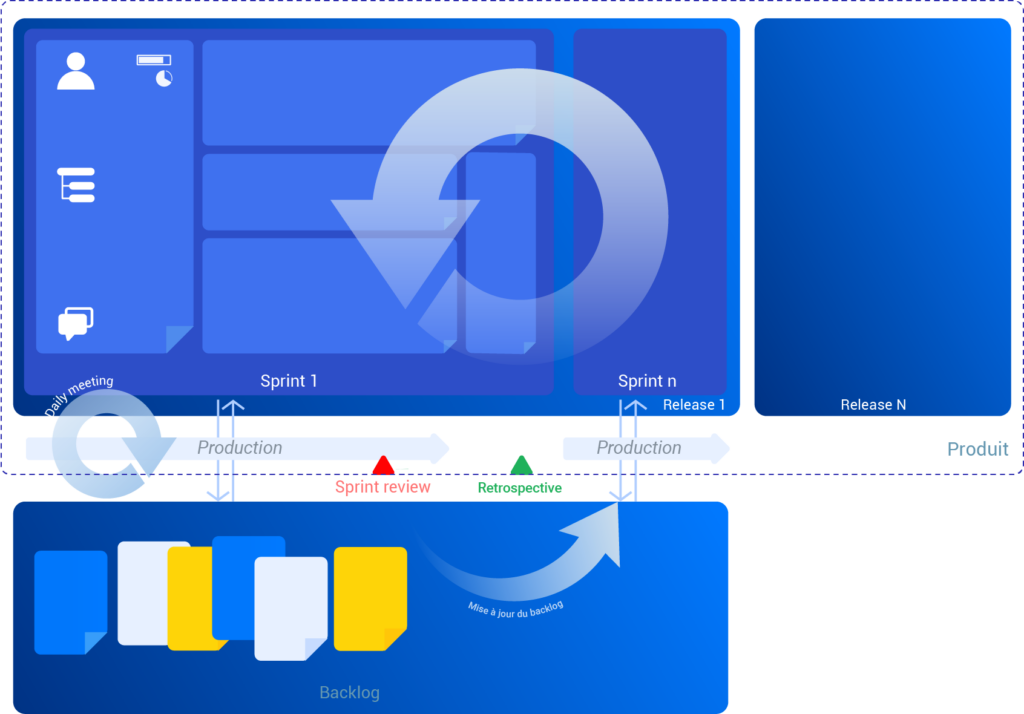Everyone talks about Scrum as if understanding it were a given… So this article aims to remind us exactly what the Scrum method is.

Scrum is an agile development framework based on an iterative and incremental approach. With Scrum, the team is small, close-knit, self-organized and multidisciplinary. Scrum is based on collective intelligence and collaborative work. Indeed, each team member self-assigns the tasks he or she wants to carry out, which fosters commitment and motivation. The development team works on small, prioritized deliverables and delivers an increment called a Sprint. With Scrum, we don’t talk about failure or error, but rather about experience. Indeed, Scrum is based on empiricism: all work must be done transparently, so that we can inspect and make adjustments. To successfully implement Scrum, there are 5 values that the team must take into consideration: commitment, focus, openness, respect and courage.
In order to achieve the overall objective, and satisfy the customer, Scrum relies on 5 events to guarantee efficient work and the right response to the customer’s needs:

Sprint: This is the container event, a period of 2 to 4 weeks that constitutes a work increment, a set of deliverables. The development team’s aim is to deliver the expected functionalities and make the necessary adaptations and changes.
Sprint planning: During Sprint Planning, the whole team establishes the tasks to be carried out for the coming iteration, and 3 questions are then asked: Why is this Sprint important? What can be done during this Sprint? How will the chosen work be carried out? These questions enable the Product Owner to explain which requirements (User Stories) have priority over others, and the development team then selects the elements (from the so-called Backlog) to be included in the Sprint. Together, the whole team sets the Sprint objective, and it is the development team that determines when it is time to update the Sprint Backlog. Thus, the objective of each Sprint Planning is a Sprint Backlog, and each Sprint Backlog contains a Sprint Goal, which is a technical task description that refines the User Stories, which are merely a non-technical description of the requirement. In the Agile spirit, the work on each task is estimated, and the sum of the estimates must not exceed the team’s known capacity for a sprint, thus finalizing the constitution of the Sprint. The sprint can then begin.
Daily Scrum: To check progress and adapt the Sprint Backlog if necessary, the development team participates in the Daily Scrum. This is a daily meeting for the development team, lasting 15 minutes. It takes place around the Scrum Board, in complete transparency. Each team member answers 3 questions: What did I do the day before? What am I doing today? Are there any sticking points? Accordingly, the sprint adapts day by day.
Sprint Review : At the end of each Sprint, the whole team gets together: the development team, the Product Owner who is the customer’s contact person, the Scrum Master who plays the role of Scrum facilitator and coach, and the customer to perform a demonstration. During this ceremony, the development team will present what has been done during the work increment. The product backlog is then updated, and the customer can refine his requirements and redefine priorities for the next Sprint.
Sprint Retrospective: This is the last event of a Scrum iteration. It’s a meeting that takes place directly after the Sprint Review, with the Scrum Team only, and its aim is to evaluate what happened during the Sprint and propose operational improvements for future iterations.
Scrum enables the development team to work in a flexible work environment that adapts to its capabilities. It’s a working environment that gives the team confidence, and is therefore motivating. And Scrum enables the customer to keep a close eye on progress, adapting to his needs as they evolve.


